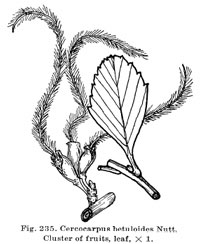Woody California native plants found at Jasper Ridge Biological Preserve
Several entries in the encyclopedia point to this page. These California native plants are present at Jasper Ridge Biological Preserve. They are not confirmed from other campus locations either growing wild or cultivated. See the Jasper Ridge Oakmead Herbarium for local photographs and more information.

Jasper Ridge Biological Preserve, located on 1200 acres of Stanford land about 3 miles from the center of campus, is of particular interest to plant enthusiasts. The natural flora of the area can be visited and appreciated. Native shrubs, wildflowers, ferns, and grasses are of special interest; docents will show them to you and provide trail guides and maps. As for trees, many of those on Jasper Ridge grow on campus, either as original inhabitants or as transplants. As an additional experience, you can see them in their native state and in their own plant communities (call 650.327.2277 to arrange a tour).
Jasper Ridge is bracketed on the north by San Francisquito Creek, which eventually empties into San Francisco Bay. Near the east side is Los Trancos Creek, which runs alongside Alpine Road and joins San Francisquito Creek where Piers Lane meets Alpine Road. Separating the ridge from the Santa Cruz Mountains on the southwest side is the San Andreas Fault (Portola Road) and Corte Madera Creek, which runs into Searsville Lake.
As a geological entity Jasper Ridge has the peculiarity of differing from its surroundings by a narrow outcropping of serpentine that slices across the preserve and is exposed to view on the approach via Escobar Road, Portola Valley. Associated with the serpentine are other Franciscan rocks including graywacke, greenstone (altered basalt not the greenish serpentine), and cherts. The latter are familiar in the residential area and greenbelt as cherry- to fist-sized, somewhat rounded, stones in various shades of red and yellow; they surface when residents dig into the black campus adobe. Jasper Ridge was named for our red cherts. (Of the 12 semiprecious stones that adorned the square breast plate of Aaron, the one in the bottom left hand corner was a jasper.) Stone similar to the serpentine from Jasper Ridge was used for the circular walls at the eastern corners of Skilling Auditorium and on the steps leading down to the north from the Mitchell Building.
The plant community supported by the soils derived from the serpentine is the home of creatures, notably butterflies, that can live only in association with that community. Thus we have geological districts that are in effect islands that imprison these butterflies. As with the analogous Galápagos Islands, life forms have taken paths that have been of significance to observational studies of evolution, as Charles Darwin originally noted when he voyaged on the Beagle to the Galápagos. When William H. Brewer surveyed California in the 1860s the native grasses were already under pressure from wild oats and other introduced grasses from the Mediterranean region, but on Jasper Ridge many natives have managed to survive for study, though admittedly heavily outnumbered by nonnatives measured by coverage or biomass.
The History of Jasper Ridge, by Dorothy Regnery, a 1991 centennial publication of the Stanford Historical Society, offers an account of the role played by Jasper Ridge in the development of this area since the earliest European settlers arrived in the 18th century. Outline of land uses.
California native trees, shrubs, and vines found at Jasper Ridge that have separate entries in the Encyclopedia include:
Acer macrophyllum (Bigleaf Maple) | Acer negundo californicum (Box Elder) | Aesculus californica (Buckeye) | Alnus rhombifolia (White Alder) | Arbutus menziesii (Madrone) | Baccharis pilularis (Coyote Bush) | Cercocarpus betuloides (Mountain mahogany) | Dirca occidentalis (Western Leatherwood) | Euonymous occidentalis (Western Burning Bush) | Garrya elliptica (Coast Silktassel) | Heteromeles arbutifolia (Toyon) | Juglans hindsii californica (California Black Walnut) | Pinus radiata (Monterey Pine)* | Populus balsamifera trichocarpa (Black Cottonwood) | Prunus ilicifolia (Holly-Leaf Cherry) | Pseudotsuga menziesii (Douglas Fir) | Quercus agrifolia (Coast Live Oak) | Quercus chrysolepis (Canyon Live Oak) | Quercus douglasii (Blue Oak) | Quercus kelloggii (California Black Oak) | Quercus lobata (Valley Oak) | Quercus wislizeni (Interior Live Oak) | Rhamnus californica (Coffeeberry) | Rhus integrifolia (Lemonade Berry)* | Salix exigua Narrow-leaved Willow) | Salix laevigata (Red Willow) | Salix lasiolepis (Arroyo Willow) | Salix lucida lasiandra (Yellow Willow) | Sambucus mexicana (Blue Elderberry) | Sequoia sempervirens (Coast Redwood) | Toxicodendron diversiloba (Poison Oak) | Umbellularia californica (California Bay)
* not native to site
Illustrations: CalPhotos
Name derivation: California Plant Names: Latin and Greek Meanings and Derivations, Compiled by Michael L. Charters



